- Share
The Consequences of Exposure to Violence during Early Childhood
We investigate the impact that exposure to violence in childhood has on an individual's propensity to engage in risky behaviors later in life and their probability of dying young. We document that black young males in the United States are exposed to much more violence in early childhood than their white counterparts. We also show that exposure to violence has a strong relationship with a host of undesirable later outcomes, and that relationship tends to be the same regardless of race, household income, mother's educational attainment, or family structure.
The views authors express in Economic Commentary are theirs and not necessarily those of the Federal Reserve Bank of Cleveland or the Board of Governors of the Federal Reserve System. The series editor is Tasia Hane. This paper and its data are subject to revision; please visit clevelandfed.org for updates.
Children in the United States grow up in a wide variety of environments, and this influences the skills they acquire. Consider something as simple as words: Hart and Risley (2003) found that by age 3, children in high-income households were exposed to over three times as many words as children in low-income households. This translated into very different vocabularies by age 3, which were then highly predictive of vocabulary at age 10. Through such effects on the skills that children acquire, the childhood environment is a major determinant of labor market success later in life.
Perhaps the most basic feature of anyone’s environment, but especially a child’s, is personal security. When exposed to violence, all other concerns take a back seat to ensuring personal security—whether in terms of economic development or personal development. A well-known literature in sociology has used qualitative methods to study the prevalence and effects of exposure to violence. Elijah Anderson’s urban ethnography documented that the state’s provision of personal security can break down in many poor, segregated, African American neighborhoods, and he showed how this breakdown creates especially difficult environments for young males to navigate (Anderson, 1999).
Recent work has quantitatively characterized features of Anderson’s ethnography (Aliprantis, 2014). This study finds that for young males, exposure to violence in childhood has a remarkably stable relationship with later risky behaviors like carrying a gun, getting in a fight, belonging to a gang, selling drugs, or getting suspended from school. The relationship between exposure to violence at a young age and risky behavior is nearly identical across racial groups, educational attainment of parents, and household types. Exposure to violence is also predictive of outcomes later in life like high school graduation and employment.
We further investigated the impact of exposure to violence on future outcomes, focusing our analysis on males, since they are more likely to be exposed to violence than females (Aliprantis, 2014). We find that exposure to violence in early childhood increases the probability of mortality in early adulthood for black males, as well as a host of other undesirable outcomes for both black and white young males.
Exposure to Violence
Since it is difficult to measure, we use two sources of data to assess exposure to violence. One is mortality data from the Centers for Disease Control and the National Center for Health Statistics (CDC/NCHS), and the other is the National Longitudinal Survey of Youth 1997 (NLSY97), which is conducted by the Bureau of Labor Statistics (BLS). The CDC/NCHS data come from death certificates, so they are records of all deaths in the United States. The NLSY97 is a nationally representative sample of individuals living in the United States in 1997 who were born between 1980 and 1984. One of the questions on the survey—whether respondents had seen someone shot at before they were 12 years old—is used to measure exposure to violence.
Looking at the data from the CDC/NCHS, we see major differences in the causes of mortality by race (figures 1 and 2). The most likely cause of death for white males is motor vehicles. Suicide and homicide are the next most likely causes of death, but each of these is still less than half as prevalent as motor vehicle deaths by age 30.
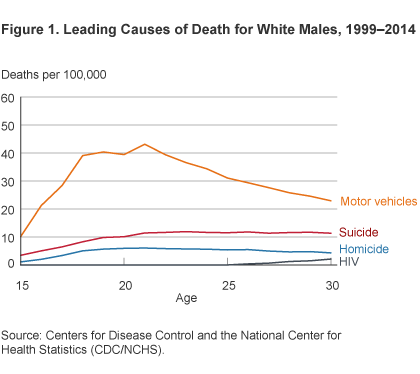
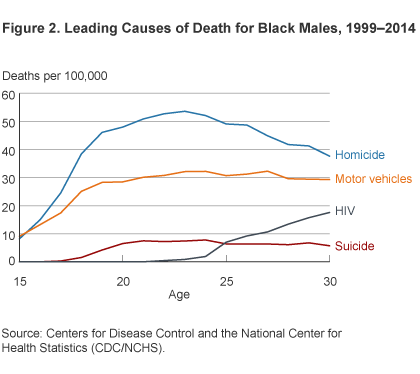
For black males, homicide is the most likely cause of death, and the contrast with white males is remarkable. At age 20, the death rate per 100,000 black males by homicide was 48, while the analogous rate for white males was 6. Given that mortality is driven primarily by homicide for young black males, it suggests that their exposure to violence is much higher than their white counterparts.
Turning to the NLSY97 data, we also see evidence of a difference in exposure to violence by race. There is a large difference across race in affirmative answers to the question about seeing someone shot at before age 12: Only 8 percent of white males report seeing someone shot at, while 26 percent of black males do.
However, because the NLSY97 data come from a survey, there are two drawbacks that could affect its validity as a measure of exposure to violence. One is the possibility of nonresponse bias, which could cause any mortality estimates derived from it to be too low. While we know that some respondents have died, some respondents cannot be found, and it is unknown if they are alive or not.
To address this issue, we calculate mortality rates using the NLSY97 data (if a respondent dies between surveys, it is recorded) and compare these rates to the mortality rates from the CDC/NCHS data. We also construct an upper bound on our mortality estimate consisting of the share of respondents known to be deceased combined with the share of respondents who did not respond to the survey because they were missing and never subsequently found. That is, the upper bound shows the response rate on a question if we assume all missing persons are dead. This is not an unreasonable assumption, given that the BLS conducts an exhaustive search for every respondent who fails to report.
We find that the mortality rates in the NLSY97 roughly match the rates in the CDC/NCHS data. This gives credibility to the estimates of mortality calculated with the NLSY97 data. Figure 3 shows that the difference in mortality across race becomes statistically different at age 19 for both calculations with the NLSY97 and remains so for most later ages, a pattern found in the CDC/NCHS as well.
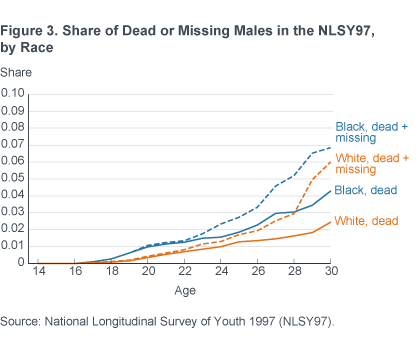
Another drawback of the NLSY97 is that answers are self-reported, so they might not be an accurate account of what respondents have really experienced. Respondents might not remember clearly or they might not fully understand the question, for example.
To investigate the credibility of the self-reported measure of exposure to violence in the NLSY97, we check whether seeing someone shot at while still young is connected to higher mortality rates. Since we have confidence in our measure of mortality, seeing someone shot at should be associated with increased mortality for black young males if it also accurately measures exposure to violence.
We find that seeing someone shot at before age 12 is associated with mortality in early adulthood for black males (figures 4 and 5). The discrepancy across exposure to violence is much weaker, if present at all, for white males. At age 23, for example, early childhood exposure increases the odds of death for black males from 1 in 100 to 1 in 33. As we can see in table 1, this difference is stable even when controlling for household income, mother’s educational attainment, and family structure. White males not exposed to violence have a mortality rate similar to their black counterparts, but white males who are exposed to violence do not experience the same increase in mortality.
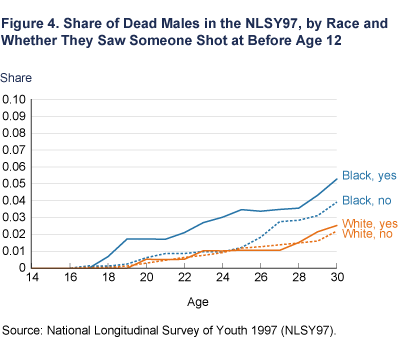
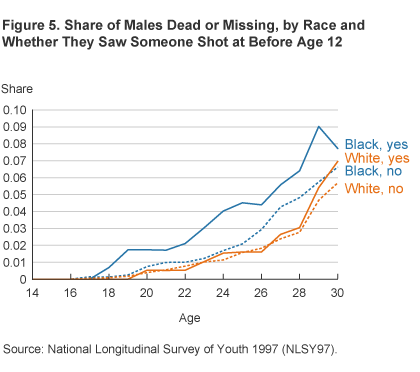
| Outcome at age 24 | Black | White | ||||
|---|---|---|---|---|---|---|
| Mean when not exposed | Difference when exposed | Difference, controlling for X’s | Mean when not exposed | Difference when exposed | Difference, controlling for X’s | |
| Dead | 1.0 | 2.1** | 2.0** | 0.9 | 0.1 | 0.2 |
| Dead or missing | 1.7 | 2.3** | 2.3** | 1.1 | 0.4 | 0.5 |
Notes: “X’s” refers to the factors household income, mother’s educational attainment, and family structure. Asterisks (*) indicate levels of statistical significance: ***= 1 percent; **= 5 percent; *= 10 percent.
Exposure to Violence and Risky Behaviors
We now proceed to investigate how early childhood exposure to violence is related to a host of risky behaviors, both violent and nonviolent, using the NLSY97. The NLSY97 provides a rich set of information about respondents, such as their childhood environments and their education and labor market outcomes. As a result, these data allow us to investigate the relationship that mortality and other outcomes have with the childhood environment.
Regressions on the data show that black males are much more likely to carry a gun, attack someone, or belong to a gang at age 16 when they have been exposed to violence during early childhood (table 2). This difference changes very little when controlling for household income, mother’s educational attainment, and family structure. The association for white males is very similar, and for some risky behaviors is even stronger than for black young males.
| Outcome at age 16 | Black | White | ||||
|---|---|---|---|---|---|---|
| Mean when not exposed | Difference when exposed | Difference, controlling for X’s | Mean when not exposed | Difference when exposed | Difference, controlling for X’s | |
| Carried a gun | 7.3 | 6.7*** | 6.2*** | 7.5 | 8.4*** | 8.3*** |
| Attacked someone | 11.4 | 7.9*** | 7.7*** | 8.6 | 13.2*** | 12.3*** |
| Belonged to a gang | 3.4 | 3.5*** | 3.0** | 1.8 | 3.2*** | 2.2** |
| Arrested for assault | 1.9 | 1.9* | 1.6 | 0.7 | 2.5*** | 2.3*** |
| Any of these violent behaviors | 18.4 | 13.3*** | 12.4*** | 15.5 | 16.3*** | 15.0*** |
Notes: “X’s” refers to the factors household income, mother’s educational attainment, and family structure. Asterisks (*) indicate levels of statistical significance: ***= 1 percent; **= 5 percent; *= 10 percent.
When exposed to violence during early childhood, black males are also more likely at age 16 to be suspended from school, to have sold drugs, to have committed a property crime, or to have been arrested for a nonviolent behavior than those not exposed (table 3).
| Outcome at age 16 | Black | White | ||||
|---|---|---|---|---|---|---|
| Mean when not exposed | Difference when exposed | Difference, controlling for X’s | Mean when not exposed | Difference when exposed | Difference, controlling for X’s | |
| Suspended from school | 13.9 | 6.4*** | 5.8** | 10.3 | 6.2*** | 4.0** |
| Sold drugs | 5.9 | 4.9*** | 4.4** | 9.0 | 8.3*** | 7.6*** |
| Property crime | 9.6 | 5.2** | 5.1** | 13.4 | 7.9*** | 8.0*** |
| Stole something worth more than $50 | 3.5 | 2.1 | 1.7 | 4.9 | 4.5*** | 4.3*** |
| Nonassault arrest | 7.0 | 9.8*** | 9.1*** | 6.4 | 7.9*** | 6.8*** |
| Any of these nonviolent behaviors | 29.4 | 17.3*** | 16.4*** | 29.4 | 14.2*** | 12.4*** |
Notes: “X’s” refers to the factors household income, mother’s educational attainment, and family structure. Asterisks (*) indicate levels of statistical significance: ***= 1 percent; **= 5 percent; *= 10 percent.
This association changes little, again, when controlling for household income, mother’s educational attainment, and family structure. The association for white males is also very similar, and just as it was for violent behaviors, even stronger than for black young males for some nonviolent risky behaviors.
Finally, we see that early childhood exposure to violence has a strong relationship with not attending school at age 17 (table 4). Black males exposed to violence are almost 12 percentage points less likely to be attending school, and controlling for household income, mother’s educational attainment, and family structure does little to change this association. And just as we saw for other risky behaviors, the likelihood of not attending school has an even stronger relationship with early childhood exposure for white males.
| Outcome at age 17 | Black | White | ||||
|---|---|---|---|---|---|---|
| Mean when not exposed | Difference when exposed | Difference, controlling for X’s | Mean when not exposed | Difference when exposed | Difference, controlling for X’s | |
| Enrolled in school | 71.3 | −11.6*** | −10.1*** | 80.8 | −19.2*** | −15.7*** |
| In prison | 1.7 | 0.3 | 0.1 | 0.5 | 1.4** | 1.4** |
Notes: “X’s” refers to the factors household income, mother’s educational attainment, and family structure. Asterisks (*) indicate levels of statistical significance: ***= 1 percent; **= 5 percent; *= 10 percent.
Discussion
This article has documented that black young males in the United States are exposed to much more violence in early childhood than their white counterparts, as measured both by children’s perceptions and their subsequent mortality in early adulthood. We have also shown that exposure to violence has a strong relationship with a host of undesirable later outcomes, and that this relationship tends to be the same regardless of race, household income, mother’s educational attainment, or family structure.
We can think of at least two obvious ways that exposure to violence could negatively affect a child’s development. First is the direct effect: The stress caused by exposure to violence has major negative consequences on children’s development through the physiological reaction our bodies have to such stress (See the discussion in chapter 1 of Tough, 2012).
Second is the indirect effect operating through expectations. One set of expectations pertains to children’s beliefs about how they will interact with other people and the type of society in which they live. Another set of expectations is defined by how children perceive their own futures. Consider that adults entering retirement can accurately forecast their survival probabilities (Hurd and McGarry 1995) and make choices reflecting those forecasts (Hurd, Smith, and Zissimopoulos, 2004). A young male might make very different decisions when facing a 1 in 20 chance of dying by age 30 rather than a 1 in 50 chance.
We can also think of two complementary policy approaches to addressing the problems caused by violence in the environments of some children. One comes at the issue from the question of “How can we prevent children from being exposed to violence?” And the other comes at it from the perspective of “What tools might we be able to give them to help navigate their environments?”
The first approach seeks to improve the environments in which kids grow up, by way of improving early childhood education or enhancing school and home environments. A couple of innovative programs currently attracting attention along these lines include Community-Oriented Policing Services (COPS), which is intended to make neighborhoods safer (see page 12 of National Crime Prevention Council, 2007) and the Promise Neighborhood Initiative, which is focused on improving educational outcomes.
The second approach to mitigating the effects of exposure to violence is to equip children with tools to help lessen the environmentally determined component of skill development and magnify the individually determined component. Some examples include giving kids access to technologies like books and the internet (Khan, 2012) or equipping them with strategies like mental contrasting with implementation intentions, a visualization technique shown to improve goal attainment (Tough, 2012, p. 92). The adoption of trauma-informed practices by schools and social service providers is another tool that can reduce the negative consequences of exposure to violence (Steele and Malchiodi, 2012).
References
- Aliprantis, Dionissi, 2014. “Human Capital in the Inner City,” Federal Reserve Bank of Cleveland, Working Paper no. 13-02R. An updated version of this paper is available at http://dionissialiprantis.com/pdfs/HCIC.pdf.
- Anderson, Elijah, 1999. Code of the Street: Decency, Violence, and the Moral Life of the Inner City. W. W. Norton and Company.
- Hart, Betty, and Todd R. Risley, 2003. “The Early Catastrophe: The 30 Million Word Gap by Age 3,” American Educator, 27:1) 4-9.
- Hoyert, Donna L., 2012. “75 Years of Mortality in the United States, 1935-2010,” NCHS Data Brief No. 88.
- Hurd, Michael, and Kathleen McGarry, 1995. “Evaluation of the Subjective Probabilities of Survival in the Health and Retirement Study,” Journal of Human Resources, 30, S268-S292.
- Hurd, Michael D., James P. Smith, and Julie M. Zissimopoulos, 2004. “The Effects of Subjective Survival on Retirement and Social Security Claiming,” Journal of Applied Econometrics, 19:6, 761-775.
- Khan, Salman, 2012. The One World Schoolhouse: Education Reimagined. Twelve.
- National Crime Prevention Council, 2007. “Improving Police-Community Relations Through Community Policing.”
- Steele, William, and Cathy A. Malchiodi, (editors), 2012. Trauma-Informed Practices with Children and Adolescents. Routledge.
- Tough, Paul, 2012. How Children Succeed: Grit, Curiosity, and the Hidden Power of Character. Houghton Mifflin Harcourt.
Suggested Citation
Aliprantis, Dionissi, and Anne Chen. 2016. “The Consequences of Exposure to Violence during Early Childhood.” Federal Reserve Bank of Cleveland, Economic Commentary 2016-03. https://doi.org/10.26509/frbc-ec-201603
This work by Federal Reserve Bank of Cleveland is licensed under Creative Commons Attribution-NonCommercial 4.0 International




